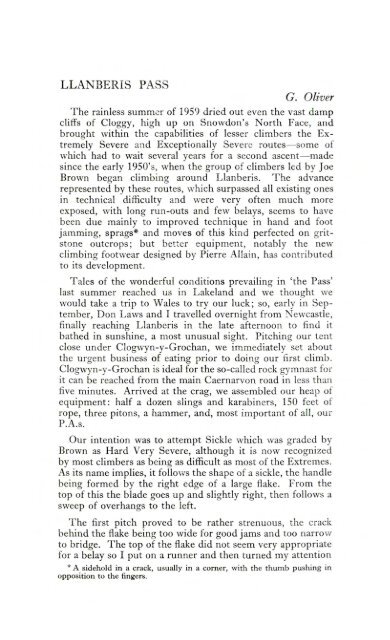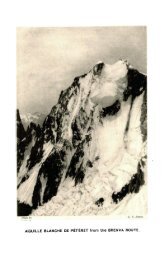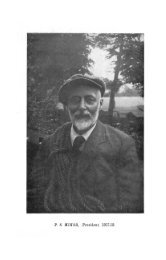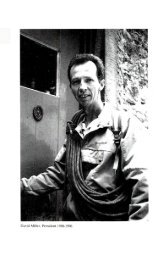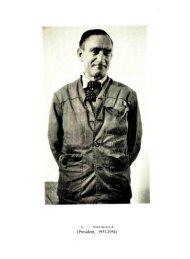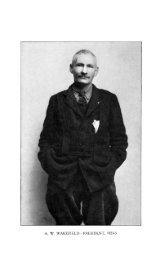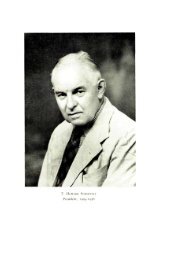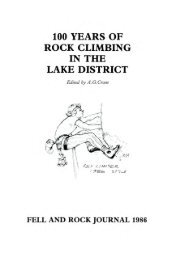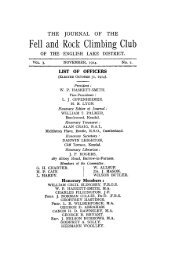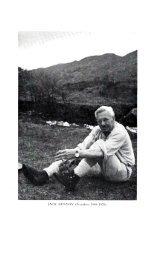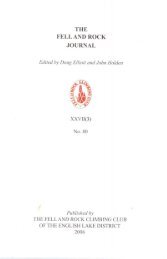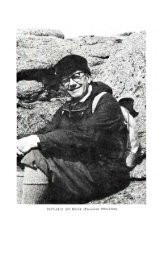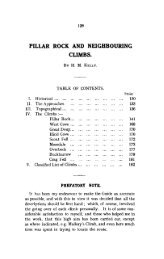Year of publication 1960 - Fell and Rock Climbing Club
Year of publication 1960 - Fell and Rock Climbing Club
Year of publication 1960 - Fell and Rock Climbing Club
You also want an ePaper? Increase the reach of your titles
YUMPU automatically turns print PDFs into web optimized ePapers that Google loves.
LLANBERIS PASSG. OliverThe rainless summer <strong>of</strong> 1959 dried out even the vast dampcliffs <strong>of</strong> Cloggy, high up on Snowdon's North Face, <strong>and</strong>brought within the capabilities <strong>of</strong> lesser climbers the ExtremelySevere <strong>and</strong> Exceptionally Severe routes—some <strong>of</strong>which had to wait several years for a second ascent—madesince the early 1950's, when the group <strong>of</strong> climbers led by JoeBrown began climbing around Llanberis. The advancerepresented by these routes, which surpassed all existing onesin technical difficulty <strong>and</strong> were very <strong>of</strong>ten much moreexposed, with long run-outs <strong>and</strong> few belays, seems to havebeen due mainly to improved technique in h<strong>and</strong> <strong>and</strong> footjamming, sprags* <strong>and</strong> moves <strong>of</strong> this kind perfected on gritstoneoutcrops; but better equipment, notably the newclimbing footwear designed by Pierre Allain, has contributedto its development.Talcs <strong>of</strong> the wonderful conditions prevailing in 'the Pass'last summer reached us in Lakel<strong>and</strong> <strong>and</strong> we thought wewould take a trip to Wales to try our luck; so, early in September,Don Laws <strong>and</strong> I travelled overnight from Newcastle,finally reaching Llanberis in the late afternoon to find itbathed in sunshine, a most unusual sight. Pitching our lentclose under Clogwyn-y-Grochan, we immediately set aboutthe urgent business <strong>of</strong> eating prior to doing our first climb.Clogwyn-y-Grochan is ideal for the so-called rock gymnast forit can be reached from the main Caernarvon road in less thanfive minutes. Arrived at the crag, we assembled our heap <strong>of</strong>equipment: half a dozen slings <strong>and</strong> karabiners, 150 feet <strong>of</strong>rope, three pitons, a hammer, <strong>and</strong>, most important <strong>of</strong> all, ourP.A.s.Our intention was to attempt Sickle which was graded byBrown as Hard Very Severe, although it is now recognizedby most climbers as being as difficult as most <strong>of</strong> the Extremes.As its name implies, it follows the shape <strong>of</strong> a sickle, the h<strong>and</strong>lebeing formed by the right edge <strong>of</strong> a large flake. From thetop <strong>of</strong> this the blade goes up <strong>and</strong> slightly right, then follows asweep <strong>of</strong> overhangs to the left.The first pitch proved to be rather strenuous, the crackbehind the flake being too wide for good jams <strong>and</strong> too narrowto bridge. The top <strong>of</strong> the flake did not seem very appropriatefor a belay so I put on a runner <strong>and</strong> then turned my attention* A sidehold in a crack, usually in a corner, with the thumb pushing inopposition to the fingers.


